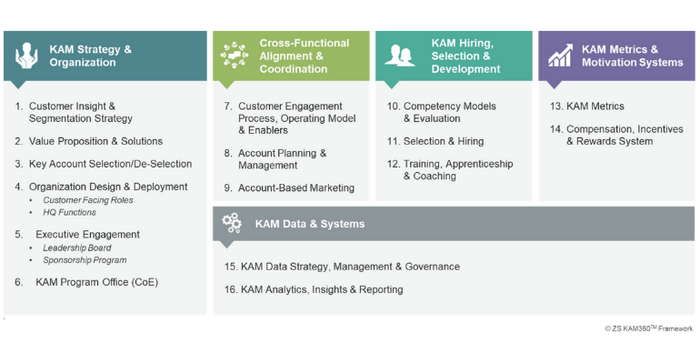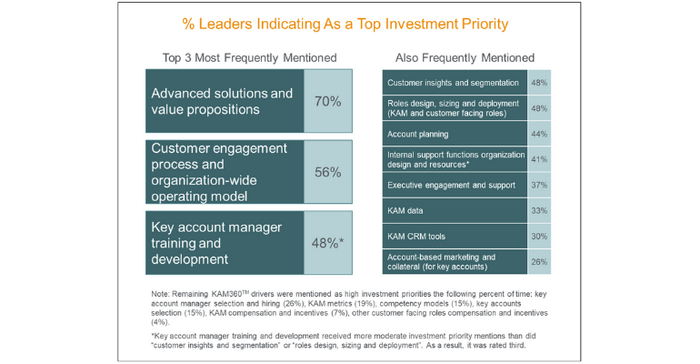Key Account Management Is a Priority for Medtech Leaders
The rise of organized customers is demanding investment in advanced solutions and next-generation key account management for a significant majority of medtech companies.
June 10, 2021

Rohan Agni, associate principal at ZS; and Mike Moorman, principal at ZS
The continued rise of large, complex, and sophisticated organized customers1 in the U.S. healthcare system is creating new imperatives and opportunities for medtech organizations. Recently completed research conducted by ZS, in partnership with the Strategic Account Management Association, provides critical insight into the challenges, opportunities, and priorities for the medtech leaders responsible for their company’s organized customer strategy, capabilities, and impact. This article outlines key takeaways from this groundbreaking research, and implications for medtech leaders.
Research Motivation
The “State of Key Account Management in Medtech” research study was motivated by continuing trends in healthcare that, in combination, stand to have profound implications for medtech organizations. In short, organized customers are becoming increasingly dominant in the healthcare system. Consider the following:
In 2018, 67% of community hospitals in the United States were affiliated with health systems compared to 58% in 2010.2
Large organized providers in the form of alternative site of care “chains” have rapidly emerged and include ambulatory surgery centers, imaging centers, urgent care clinics, retail care clinics, long-term care facilities and home health agencies.
Health systems are themselves acquiring alternate sites of care3 as well as integrating vertically with payers and taking on insurance risks for various patient populations that they serve.
And while these organized customers vary in terms of size, degree of integration, sophistication, and the local healthcare markets in which they operate—what they have in common is pivotal4:
Increased need for external partnerships to achieve their individual objectives relative to the quadruple aim
Increased centralization of control in decision-making to manage costs and improve care delivery
Increased reliance on value-added committees to make product and partnering decisions based on a broad set of both clinician and non-clinician needs and priorities
Increased desire for risk-reward based agreements with manufacturers (such as value-based care)
The evolving prominence, power, and priorities of organized customers is in many ways a game-changer for medtech. As many medtech leaders commented during the research, the age-old standard of selling products to clinicians won’t be sufficient for success in the emerging environment—especially with decreasing clinician autonomy to choose the products they individually prefer. And the clock is ticking. Medtech leaders need to invest in advanced solutions beyond the basic product to address the broader needs and priorities of organized customers. At the same time, they must invest organizationwide in the next-generation key account management (KAM) required to tailor advanced solutions, secure customer commitments and deliver on the value proposition. The alternative is ever-increasing commoditization.
Research Design and Participation
The “State of KAM in Medtech” research provides comprehensive and granular insight into the objectives, organizational models, support functions, current effectiveness, barriers, metrics and investment priorities for the medtech industry. Throughout the study, KAM was defined as an “organizationwide business strategy” and not simply as a role (see Figure 1).

Figure 1 – KAM is an organizationwide business strategy (ZS KAM360)
Participants included 27 leaders of KAM functions, representing enterprise or business unit KAM organizations at 15 top medtech companies. Together, the participating companies span the full spectrum of major product categories and platforms offered by medtech manufacturers.
Data collection for the research took place from Q3 to Q4, 2020—with each of the 30 participating leaders taking part in a comprehensive 45-minute online survey facilitated live by a ZS business consultant.
Here are a number of high-level takeaways from this comprehensive research.
Research Highlights
The research results underscore that most medtech companies have a foundation and future aspiration upon which to build advanced KAM strategies and capabilities. In particular, a number of KAM-related bright spots for the medtech industry include the following:
There are at least a handful of medtech companies that report a high level of effectiveness for every one of the 16 drivers of KAM effectiveness as defined by the KAM360 framework, with a range of best practices cited.5
An overwhelming majority (92%) of KAM leaders perceive that the senior-most executives in their organization view KAM as a strategic priority for the company.
There is a strong intention to move to next-generation KAM models that can tailor and deliver advanced solutions that address a broader range of organized customer needs and priorities, recognizing that the majority of medtech organizations aren’t at this point today.
While these points are encouraging, the research also revealed that the vast majority of medtech companies need to make substantial advancement in their KAM strategies and capabilities if they’re to maximize impact and success with organized customers.
While a detailed readout is beyond the scope of this article, some of the highest priorities in medtech are summarized here and in Figure 2:
Development of advanced solutions and value propositions targeted to the unique needs and priorities of organized customers was identified by 70% of leaders as one of their organization’s most critical investment priorities. Our research also found:
A lack of marketing support and value propositions for organized customers (not clinicians) was cited as the key barrier to organized customer impact by 78% of leaders.
Over half (52%) of leaders indicated that their company has no KAM-specific marketing support6—relying solely on traditional brand and product marketing for KAM.
A majority of leaders (81%) indicated internal misalignment between individual business-unit-to-business-unit or business-unit-to-enterprise value propositions as a major barrier for their organization.
A mere 11% of leaders rated their organization as highly effective in the areas of value proposition, account-based marketing and customer insight and segmentation.
Development of next-generation customer engagement processes and organizationwide operating models was the second most identified investment priority, with 56% of leaders indicating this area as critical to future success. The move toward advanced solutions will require different customer-engagement processes—plus more effective orchestration of customer-facing roles and better alignment of internal functions that support and enable KAM. Customer engagement process and operating model are the “backbone” of any KAM program. Related to this:
Brand-centric planning and engagement—as opposed to customer-centric planning and engagement—was cited as one of the top barriers to KAM success by 77% of leaders.
Only 11% of leaders rated their organization’s customer engagement process and operating model as highly effective.
More than half (55%) of medtech leaders believe KAM is not a well understood role in the company.
Internal role clarity and conflict was cited as a major or moderate barrier in at least 48% of medtechcompanies.
Almost two-thirds of leaders (63%) indicated that short-term focus at the expense of long-term value is a major barrier to the organization’s ability to achieve a strategic approach to customers.
Competency and skills of the key account managers was the third highest-rated investment priority, with 48% of leaders indicating this priority.
KAM training and development received one of the lowest effectiveness scores of all, with only 7% of leaders indicating a high degree of effectiveness in this area.
Competency model scores were somewhat better, with 33% of leaders indicating a high degree of effectiveness in the area. However, 30% of leaders indicated a very low level of effectiveness for KAM competency models.

Figure 2 – Percent of leaders indicating KAM as a top investment priority
It’s also interesting to note that every one of the 16 drivers in the KAM360 framework was indicated as a top investment priority by at least one of the research participants. For instance, roughly one-third of respondents indicated that their top investment priority is KAM data and tools.
The variance in investment priorities underscores two critical aspects of KAM. First, there are no silver bullets. Ultimately, it’s a system and requires effectiveness in all the drivers in order to achieve a world-class KAM capability. Second, KAM is a journey. The top investment priority for any organization is a function of where they are on that journey. No organization can or should address all the drivers at once.
Conclusions for Medtech Professionals
Medtech is at a pivotal point in its KAM evolution. As mentioned above, the evolving prominence, power and priorities of organized customers is a game-changer for many medtech manufacturers. The “State of KAM in Medtech” research findings underscore the imperative for medtech companies to invest in advanced solutions for organized customers—solutions that address broader needs and priorities beyond just core medtech products. Doing so will require next-generation customer engagement processes and operating models and enhanced individual key account manager competencies and skills. The KAM360 framework provides an essential reference for identifying priorities necessary to meet the organization “where it’s at” and ensures medtech leaders approach KAM as an organizationwide business strategy—not simply as a role.
For more information:
To inquire about purchase of the full “State of KAM in Medtech” research report, contact Joel Schaafsma ([email protected]) at the Strategic Account Management Association (www.strategicaccounts.org)
For additional insights and resources on “Achieving KAM Excellence in Life Sciences,” please contact one of the authors and find additional resources at https://www.zs.com/insights/achieving-kam-excellence-in-life-sciences
Footnotes:
Health systems such as integrated delivery networks, integrated payer and provider networks, academic medical centers, veterans affairs and veterans integrated service networks and alternate sites of care chains in settings such as ambulatory surgery centers, urgent care clinics, retail clinics, long-term care and home health agencies.
AHA Trendwatch Chartbook 2020 (https://www.aha.org/system/files/media/file/2020/10/TrendwatchChartbook-2020-Appendix.pdf)
Tenet to Acquire Portfolio of Surgery Centers from SurgCenter Development (https://investor.tenethealth.com/press-releases/press-release-details/2020/Tenet-to-Acquire-Portfolio-of-Surgery-Centers-from-SurgCenter-Development/default.aspx)
ZS Provider Organization Partnership Tracker Wave 3
Leaders indicating a high degree of effectiveness ranged from 41% down to 7% across the 16 KAM360 drivers. Only 7 of the 16 drivers were rated as high effectiveness by 25% or more of the respondents.
A third of respondents (33%) did indicate some form of KAM segment marketing support and 11% indicated some form of cross-functional SWOT team support.
About the Authors
Rohan Agni ([email protected]) is an associate principal in ZS’s Evanston office and specializes in medtech commercial strategy and effectiveness. Rohan is a core member of ZS’s healthcare ecosystems practice, focused on developing leading-edge customer insight, commercial model and capability solutions to maximize medtech and pharmaceutical company impact with organized customers.
Mike Moorman ([email protected]) is a principal in ZS’s Chicago office, and leads the firm’s key account management practice. Mike serves on the board of directors for the Strategic Account Management Association. Mike founded ZS’s business-to-business commercial strategy and transformation practice and has worked with more than 50 business-to-business organizations across more than 12 industries.
You May Also Like

.png?width=300&auto=webp&quality=80&disable=upscale)
